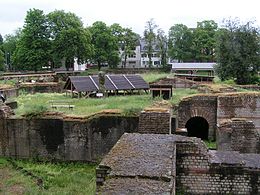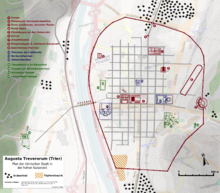
Trier, formerly and traditionally known in English as Trèves and Triers, is a city on the banks of the Moselle in Germany. It lies in a valley between low vine-covered hills of red sandstone in the west of the state of Rhineland-Palatinate, near the border with Luxembourg and within the important Moselle wine region.

In ancient Rome, thermae and balneae were facilities for bathing. Thermae usually refers to the large imperial bath complexes, while balneae were smaller-scale facilities, public or private, that existed in great numbers throughout Rome.
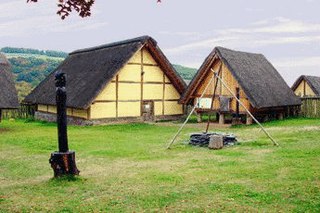
The Trēverī were a Germanic or Celtic tribe of the Belgae group who inhabited the lower valley of the Moselle in modern day Germany from around 150 BCE, if not earlier, until their displacement by the Franks. Their domain lay within the southern fringes of the Silva Arduenna, a part of the vast Silva Carbonaria, in what are now Luxembourg, southeastern Belgium and western Germany; its centre was the city of Trier, to which the Treveri give their name. Celtic in language, according to Tacitus they claimed Germanic descent. They contained both Gallic and Germanic influences.
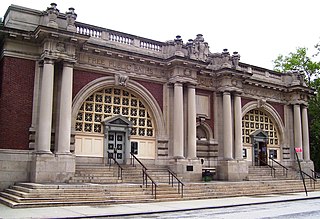
Public baths originated when most people in population centers did not have access to private bathing facilities. Though termed "public", they have often been restricted according to gender, religious affiliation, personal membership, and other criteria.

Augusta Treverorum was a Roman city on the Moselle River, from which modern Trier emerged.

A Roman circus was a large open-air venue used mainly for chariot races, although sometimes serving other purposes. It was similar to the ancient Greek hippodrome. Along with theatres and amphitheatres, circuses were one of the main entertainment venues at the time.

Brot und Spiele is Germany's biggest Roman festival, annually held in Germany's oldest city, Trier. The festival takes place at two of the city's Roman monuments: the Amphitheatre hosts theatre performances that include many gladiator fights and the Imperial Baths are used to display the civil and military life in the vicus.
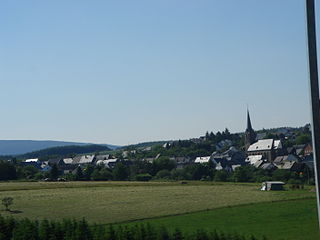
Bundenbach is an Ortsgemeinde – a municipality belonging to a Verbandsgemeinde, a kind of collective municipality – in the Birkenfeld district of Rhineland-Palatinate, Germany. It belongs to the Verbandsgemeinde Herrstein-Rhaunen, whose seat is in Herrstein.
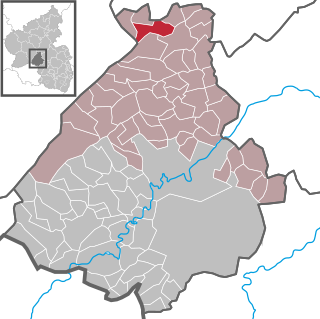
Weitersbach is an Ortsgemeinde – a municipality belonging to a Verbandsgemeinde, a kind of collective municipality – in the Birkenfeld district in Rhineland-Palatinate, Germany. It belongs to the Verbandsgemeinde Herrstein-Rhaunen, whose seat is in Herrstein.

The Aula Palatina, also called Basilica of Constantine, at Trier, Germany, is a Roman palace basilica and an early Christian structure built between AD 300 and 310 during the reigns of Constantius Chlorus and Constantine the Great.

The Rheinische Landesmuseum Trier is an archaeological museum in Trier, Germany. The collection stretches from prehistory through the Roman period, the Middle Ages to the Baroque era with a strong emphasis on the Roman past of Augusta Treverorum, Germany's oldest city. Its collections of (local) Roman sculptures, Roman mosaics and frescos are among the best in Germany.
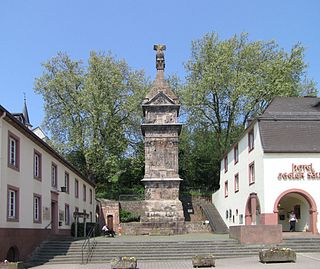
The Igel Column is a multi-storeyed Roman sandstone column in the municipality of Igel, Trier, Germany, dated to c. 250 AD. The column is the burial monument of the Secundinii cloth merchant family, and was built by two of the family members, Lucius Secundinius Aventinus and Lucius Secundinus Securus.
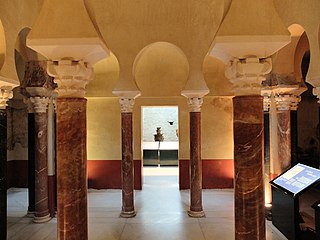
The Caliphal Baths are an Islamic bathhouse complex in Córdoba, Spain. They are situated in the historic centre which was declared a World Heritage Site by UNESCO in 1994. The complex was contiguous to the former Caliphal Palaces of the Umayyads, whose inhabitants it served. Today the baths have been partially reconstructed and are open as a museum.

The Roman Monuments, Cathedral of St. Peter and Church of Our Lady in Trier are buildings and monuments of particular historical importance in Trier, Germany, that were together listed as a UNESCO World Heritage Site in 1986. These sites demonstrate the political, economic, and historical importance of Trier during the Roman Empire as one of the four capital during the Tetrarchy period, and as a prominent city during the early days of the Holy Roman Empire in the Middle Ages.

The Trier Imperial Baths are a large Roman bath complex in Trier, Germany. The complex was constructed in the early 4th century AD, during the reign of Constantine I. During that time, Trier was a major imperial hub, being a primary residence for Constantine's son Crispus. The baths were built around hot water pools reaching 40°C. Underneath the complex was a network of underground passageways used by the staff which can still be seen today, along with the remains of the sewer system. However, the baths were never completed and were made into a castle in the Middle Ages.

49.752736°N 6.63766°E
The Forum Baths of Trier are a ruin of a Roman bath complex in Augusta Treverorum, modern-day Trier, Germany. The baths were discovered in 1987.

The preservation and extensive excavations at Ostia Antica have brought to light 26 different bath complexes in the town. These range from large public baths, such as the Forum Baths, to smaller most likely private ones such as the small baths. It is unclear from the evidence if there was a fee charged or if they were free. Baths in Ostia would have served both a hygienic and a social function like in many other parts of the Roman world. Bath construction increased after an aqueduct was built for Ostia in the early Julio-Claudian Period. Many of the baths follow simple row arrangements, with one room following the next, due to the density of buildings in Ostia. Only a few, like the Forum Baths or the Baths of the Swimmers, had the space to include palestra. Archaeologist name the bathhouses from features preserved for example the inscription of Buticoso in building I, XIV, 8 lead to the name Bath of Buticosus or the mosaic of Neptune in building II, IV, 2 lead to the Baths of Neptune. The baths in Ostia follow the standard numbering convention by archaeologists, who divided the town into five regions, numbered I to V, and then identified the individual blocks and buildings as follows: (region) I, (block) I, (building) 1.
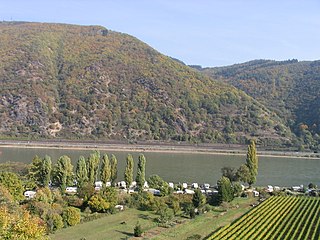
The Aresaces were Belgic tribe. They were closely related to, and probably originally part of, the Treveri. They inhabited the left bank of the Rhine in the Mainz-Bingen area, which was once the easternmost part of Treveran territory.

The Trier Gold Hoard is a hoard of 2516 gold coins with a weight of 18.5 kg found in Trier, Germany, in September 1993 during construction works. It is described as the largest preserved Roman gold hoard worldwide. The hoard is on exhibition at the Rheinisches Landesmuseum Trier.
